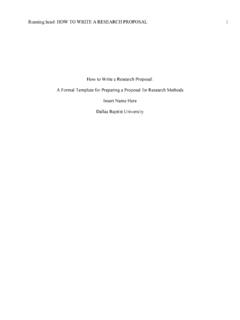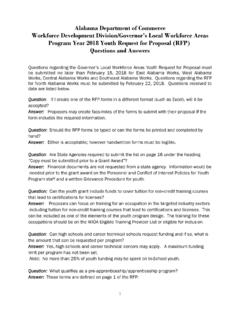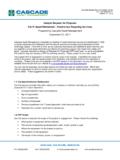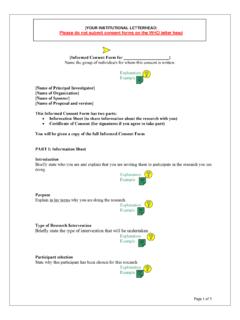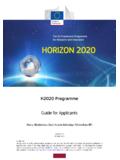Transcription of Scope of Requirements (SoR) Writing Guide and …
1 Scope of Requirements (SoR) Writing Guide and template To develop a Scope of Requirements (SOR) for the Goods and or Services required ensuring a full and detailed tender is produced with appropriate scoring. It is important to remember that SoR s are used to support the tender which is assessing the capability, capacity and commerciality of the bidders. The SOR doesn t need to provide too much detail as this could potentially create issues in terms of determining the winning bidder. It is often easier to imagine your tender as the exam paper to assess the bidders capability, capacity and commerciality against your SOR. Try to write your SOR in a sufficiently detailed manner, so as to provide enough of a basis at a later stage when you will be required to extract relevant criteria that will be used to differentiate competing proposals.
2 Remember that the selection criteria that you develop for your tender must have a logical foundation. For example, you cannot differentiate bidders on factors that would excludes others such as based on specific brands and or services that would unfairly exclude others. If Writing a performance-based SOR, try not to tie the Bidders hands by being overly prescriptive in your description of the work and the manner in which it is to be undertaken. While care should always be taken to fully describe your requirement, try to balance this by leaving bidders with the flexibility in their proposals to offer innovative and environmental considerations and strategies, and to accept maximum responsibility and accountability for the results of their work. When Writing your SOR, try to think ahead to the contract award and management stage (once the winning bidder has been selected and the work is underway).
3 In doing this, try to write your SOR in such a way as to ensure that the mutual expectations of the resulting contract will be adequately described and easily understood. Once the contract is underway, a well written SOR will go a long way to minimising potential misunderstandings and/or disputes with your supplier. Remember to always use generic (non-proprietary) terminology and references in describing your Requirements . This enables greater competition, and it also minimises the risk of a bid challenge or allegation that the Requirements were slanted to a particular bidder. There is tremendous potential within a SOR for overlap, duplication, and/or contradiction with the Terms and Conditions (t&c s) of the resulting contract. Remember the contents of the SOR are variable to define the Requirements at hand vs the t&c s which contain the standard terms and conditions of the resulting contract.
4 If it s covered-off in the t&c s, you generally don t need to worry about it in the SOR. Above all, do your best in the SOR to convey to the Bidders what it will take on their part to complete the work to your satisfaction, and accordingly what it will take for them to ultimately have their work accepted and certified for payment. 2 of 10 ** Example Scope of Requirements (SoR) template The following example SOR is designed to help subject matter experts to work through their Scope of Requirements when looking to source a supplier. Once you ve worked through the SOR you will need to arrange a meeting with Procurement who will advise and support the most appropriate method of supplier selection as required by Public Procurement regulation. 1.
5 TITLE The Title clearly and succinctly summarises the name of the requirement being contracted for, and should, at a glance , answer the question: who is trying to buy what and via what form of contracting. a. Briefly and clearly, identify the type of service being acquired, the organisation (Department, Faculty, Office, etc.,) acquiring the services. 2. BACKGROUND The Background section provides contextual information that plays a key role during the proposal solicitation stage by providing Bidders with an understanding of the organisation s requirement, its objectives and key drivers for the work to be undertaken that can assist in determining whether to bid and in preparing a Proposal. The Background section should also support the organisation s documentation of its business case, including the rationale for the work and the need to enter into contract.
6 A. Describe the mandate of the organisation (Department, Faculty, Office, etc.,) acquiring the services. b. As required, identify the authorised users of the resulting service/product. Describe the area within the organisation (Faculty, Division, etc.,) requiring the services. Similarly, identify whether the resulting service/product will be accessible by all areas within the organisation, or by only selected (and identified) authorised users. c. Describe the specific commodity (type of service) being acquired. d. At a high level, briefly describe the organisational program, project, or internal operational requirement for which the services are being acquired. The need for the work to be completed must be clearly articulated if possible, contextualise the project/requirement within the organisation/area s overall business plan.
7 3 of 10 e. If available, and if it would be helpful to Bidders in developing their proposals to provide publicly accessible informational links such as website URL s. f. Identify whether the requirement is recurring, the first in a series of similar upcoming Requirements , a subsequent phase in a multi-phase program/initiative, or a one off ( one-time only) project. If the work to be undertaken consists of planning for or Requirements definition in support of anticipated future work for which contracts will be established by the University at a later date, this should be clearly articulated, including any restrictions that may be placed on the resulting Supplier(s) from participating on the future work. This subsection can help to mitigate the risk of perceived bias and/or prior knowledge on the part of incumbent Suppliers, through the organisation s proactive disclosure of its previous activities and future intentions.
8 3. OBJECTIVE The Objective section identifies the organisation s overall outcome for the resulting contracted work, to provide a clear understanding and enforceable outcome for the work to be undertaken. The Objective also identifies the organisation s anticipated outcome of the competitive bidding process, leading to the awarding of the resulting contract(s). Its primary role at the tender stage is to provide Bidders with a clear understanding of the structure and number of resulting service/product(s) to be awarded. a. Describe in outcomes-based terminology precisely what the organisation hopes to achieve as a result of this tender. b. Indicate if it is the organisation s intent to award the resulting service/product(s) to one or multiple Suppliers.
9 C. Identify whether the required type of Supplier consists of a firm or an individual providing services, or both. 4. DEFINITIONS AND APPLICABLE DOCUMENTS Definitions and Applicable Documents section provides contextual information at both the tender and contract stages to ensure clarity in the interpretation of the SOR and identification of overarching legislation, policies, procedures and guidelines that will govern the resulting work. The purpose of this section is to mitigate ambiguity and misunderstanding that could lead to poor proposals at the tender stage, or default, breach or dispute at the contract stage. 4 of 10 5. BUSINESS AND/OR TECHNICAL ENVIRONMENT Business and/or Technical Environment section provides contextual information to Bidders at the tender stage to identify operational Requirements of the work and programs, systems and infrastructure with which the Supplier(s) will be required to work in the contract stage.
10 6. DESCRIPTION AND Scope OF WORK The Scope provides guidance at the tender stage to assist Bidders in understanding the work to be undertaken and provide clarity in developing their Proposals. At the contract stage, the Scope provides enforceable guidance to the Supplier as to where to focus its efforts in the resulting contract to ensure the Supplier remains in Scope and focussed on issues, tasks and other activities that are relevant to the completion of the work. The Scope section with a SOR describes the logical boundaries within which the work will take place ( what is the work, and what is it not?). In contrast to the deliverables under the contract (described in 8) which identify the specific, tangible items the Supplier must complete in order to receive payment, this section sets the stage for a later and more precise description of the deliverables, by first describing the work at a macro or conceptual framework level, and in more general terms.

